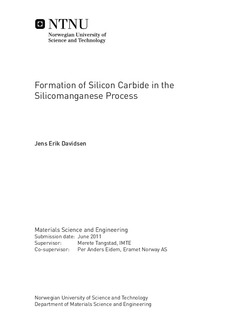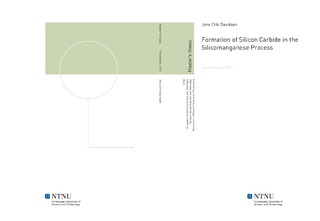| dc.description.abstract | As the silicon content in a silicomanganese alloy increase, silicon carbide becomes the stable carbon phase. Little work is published on the formation of silicon carbide in the SiMn process. This thesis examines the formation of SiC through the reaction between slag, metal and coke. The goal of the thesis has been to determine where and how SiC is formed in the silicomanganese process. Focus has been given to formation through liquid-solid reactions.The investigation was carried out by heating metal and slag together with coke. XRD analysis of SiC formed in the process, as well as wettability testing of slag and metal toward SiC and graphite substrates were also examined. The raw materials consisted of two industrial SiMn alloys, named Metal 1 and 2 in the thesis. These had 19 and 28 wt.% Si, respectively. Two slags, Slag 1 and 2, were used in combination with the metal. SiC was found to form on the coke particle through reaction with both slag and metal. The formation was fastest through the metal phase and the effect of increasing silicon content in the metal was evident. A temperature increase from 1600 C to 1650 C resulted in less SiC formed on the coke particle surface for Metal 1, but gave more SiC at the surface of the coke particle for Metal 2. The decrease in SiC on the coke particle for Metal 1 is likely to be caused by a decreased driving force, as the coexistence point of C and SiC increases with increasing temperature. For Metal 2 the relative distance is smaller, making the effect neglectable. The formation of SiC occurs at the surface of the coke particle. The metal samples indicate that carbon diffuses through the SiC layer to react with silicon in the alloy. Formation through the slag is likely to go through the reduction of SiO2 to Si, before reacting to form SiC. The XRD analysis determined beta-SiC to be the dominant phase formed through both slag and metal. alpha-SiC was found in one of the industrial slag samples, indicating temperatures higher than 1700 C. The wettability testing showed both slag and metal to be non wetting toward the SiC substrate. All angles were stable with increasing temperatures. Both slags were found to be non wetting toward graphite. The wetting angle of Slag 2 was stable with increasing temperature. Slag 1 showed decreasing wetting angle with temperature, before an abrupt change back to an angle larger than the initial angle. The sudden change is likely to be caused by a reaction product, possibly SiC, forming between the substrate and slag. | nb_NO |

